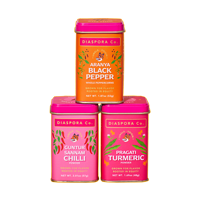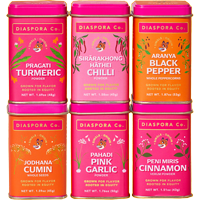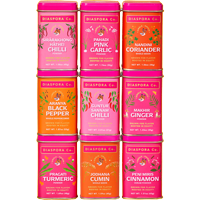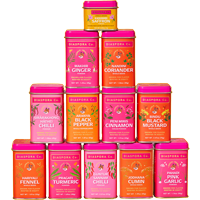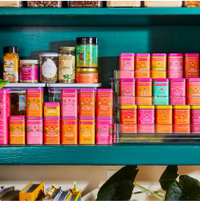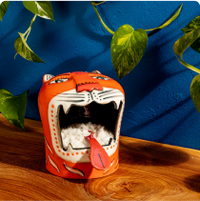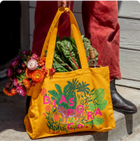It is 3pm on a cloudy afternoon in August, and I am making my way through a field of densely planted sugarcane in Pargaon, Maharashtra. Purple and green stalks tower above me, swaying and rustling in the afternoon breeze. The path is narrow, no more than a foot wide, and I proceed tentatively, arms raised to shield my face from the sharp edges of the sugarcane leaves. Ahead of me, walks Kantilal Randive, the farmer of this field, and the source of our exquisite Madhur Jaggery.
We arrive at a clearing with a water tank, open to the sky, and hanging above the water are over a dozen weaver-bird nests: delicate, hanging homes made from little twigs and bits of dried leaf. The sun dances on the water below, and above and around, little weaver birds twitter about, seemingly at home in this patch of land. As I observe them, Kantilal tells me that their nests have two openings: a true one, and a false opening meant to confuse predators, like snakes that come for their eggs and young ones. His fondness is obvious, as is his keen sense of observation.
This little oasis of weaver nests—these little moments of magical co-existence—are one of the things I love about regenerative farming. When food is grown in a manner that enriches the ecosystem, it makes for a fuller, more enriching experience. For many it touches, from the earthworms in the soil, the baya weaver birds above the water, farmers like Kantilalji, the people who cook with the produce, the loved ones they feed along the way.
The other thing I love about regenerative farming, is the flavor it brings.
There is a strong connection between the biodiversity of a habitat and the flavour of its produce: the more layered the habitat, the more complex the flavour it yields—assuming a careful selection had been made in choosing the variant being grown. In other words: terroir.
But before we dig in farther, allow me to introduce myself.
Hello fellow earth beings :) My name is Neha, and I am Diaspora’s Farm Partner Manager, which means I work on matters related to sourcing. Like finding regenerative spice farms in India and South Asia, meeting with farmers like Kantilal, listening to his triumphs and challenges, and working towards a supply chain that is rooted in collaboration, compassion, and community.
I’m also a kitchen-gardener of many years :) and have a thriving backyard garden, where I grow veggies, herbs, tubers, coffee, and fruit. I continue the practice of growing food for two reasons: The wonder I experience on a regular basis, from working alongside birds and bees and earthworms, and for the flavor it brings.
Before my life as a regenerative gardener, I lived in Mumbai, and worked as a journalist, writing about food and travel. The more I travelled, and the more delicious food I ate, the more I wondered where this food came from, and why I knew so little about it.
Long story short: I left the city, spent the next year working at organic farms in India, and eventually, moved to the mountains, where I continued my experiments with regenerative growing. I began to write about food from the perspective of habitat, co-existence, and wildlife conservation. At the heart of my quest were these questions: What would it mean to grow food regeneratively, in a way where land, community, and the Earth at large benefits? Is this even possible? What would it look like?
These questions continue to guide my work at Diaspora.
Every time I speak with a farm partner, like Kantilal, who tells me about the wealth of wildlife on his sugarcane farm, and taste the complex notes in his jaggery powder, I receive a little blip of affirmation.
We are sitting under the shade of a mango tree now, and Kantilal is telling me about how he switched to organic methods of growing about 17 years ago, chiefly due to the high cost of fertilizer and pesticide inherent in industrial growing methods. The other reason was soil depletion. He began with a trial patch, and gradually increased his growing area, until it extended to his entire farm.
Today, his 10-acre sugarcane farm is interplanted with mango and neem trees, and nourished by fermented mixes using cow dung, cow urine, rice water, jaggery, and local leaves. These brews inoculate the soil biome with beneficial microbes, which keeps soil-borne diseases in check. The mixes also add organic matter to the soil, resulting in a gradual release of nutrition.
As he talks, I notice the volume of birdcall, countless ant and termite hills, worm castings in the soil, and weeds growing in the periphery of the sugar cane—evidence that he isn't using pesticide. A few months ago, Kantilal says, he was riding through this very sugarcane field after dark, on his motorbike, when he noticed a pair of eyes glowing back at him. When he stopped, he saw a full-grown tiger ambling past the path in front of him.
To think that a wild tiger might have stalked past the sugarcane that I spoon into my coffee every morning—it’s the stuff of magic! To consider, even theoretically, all the creatures that have played a role in all the food I consume on a daily basis—staggering! And a gentle reminder of the numerous, wondrous ways that we are connected to our habitats.










